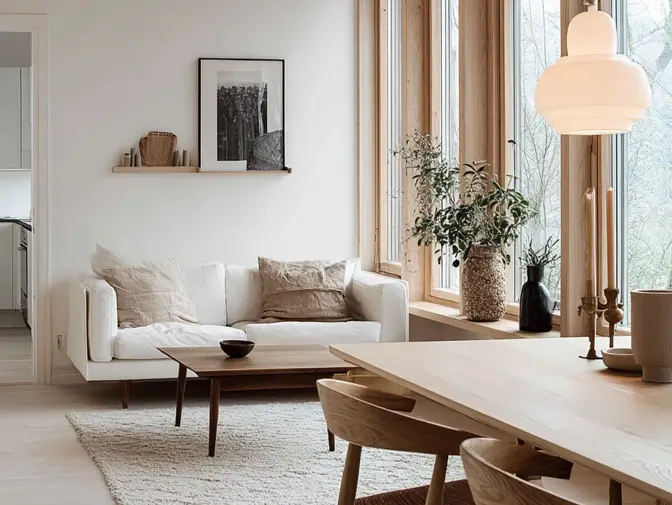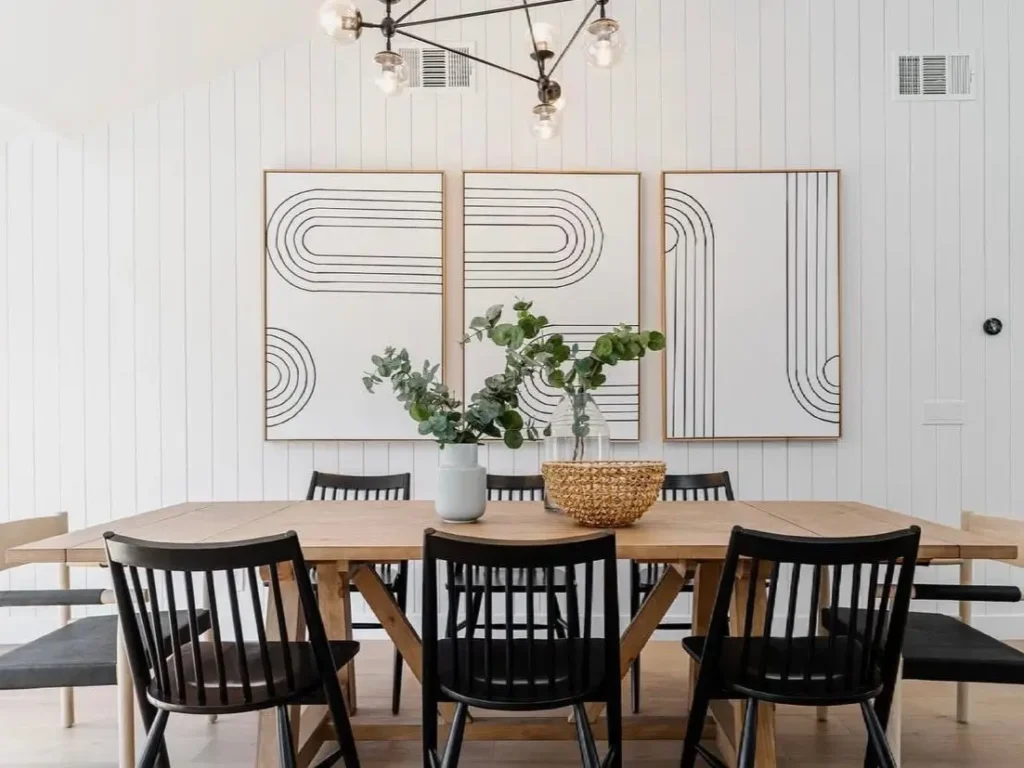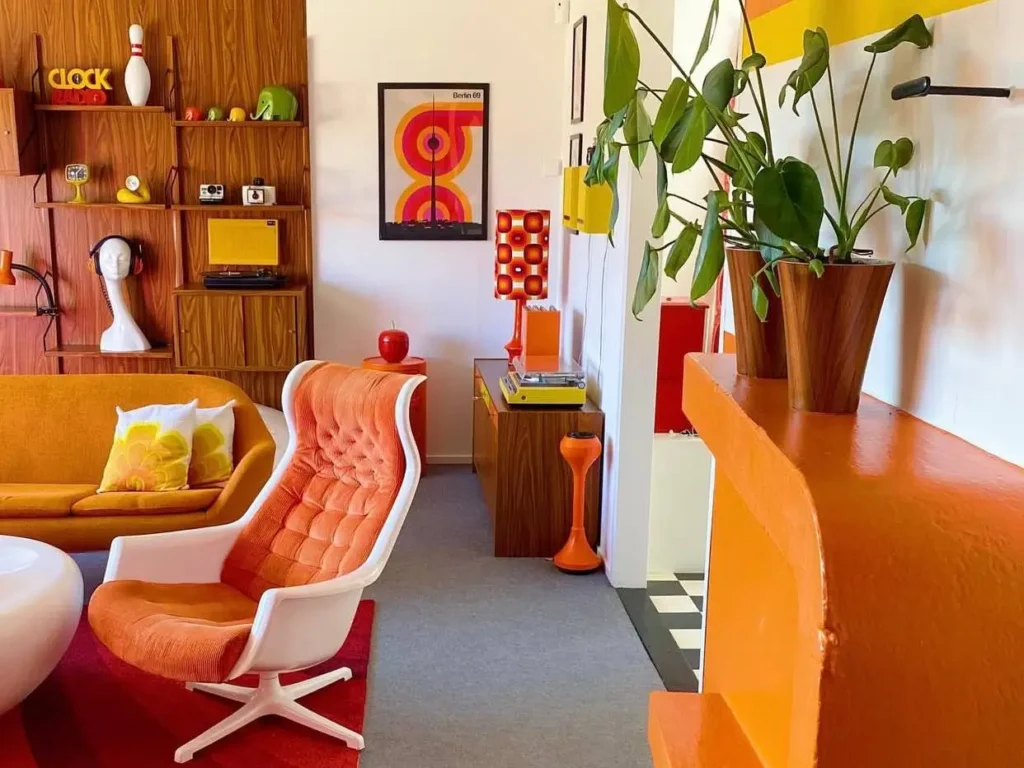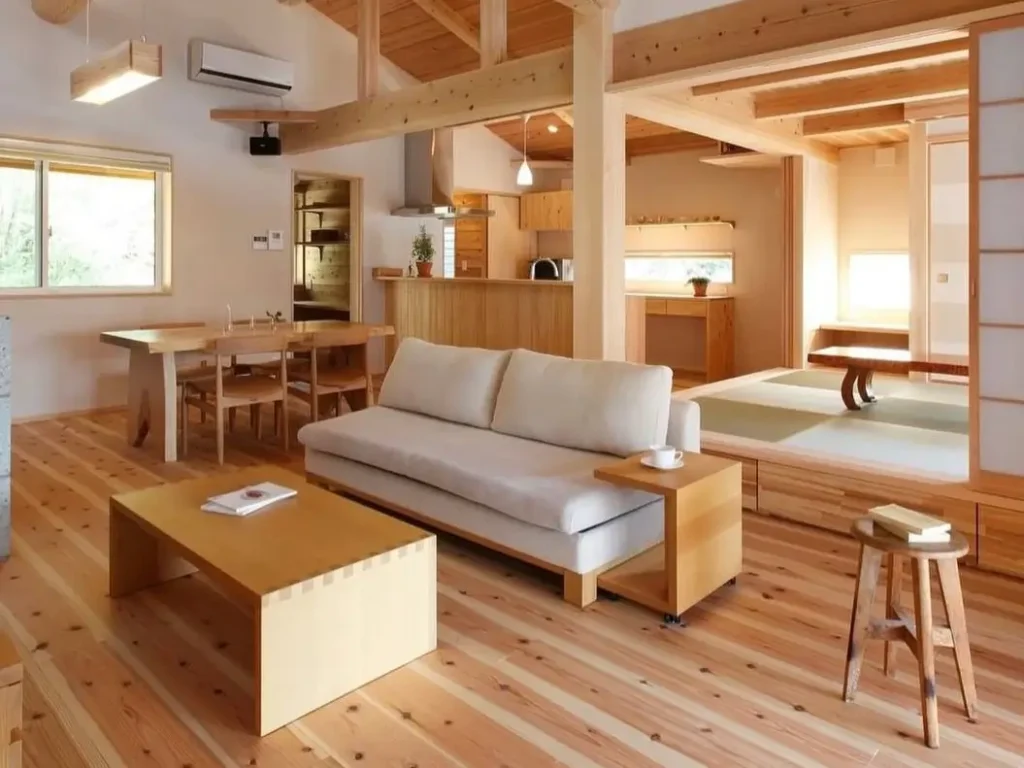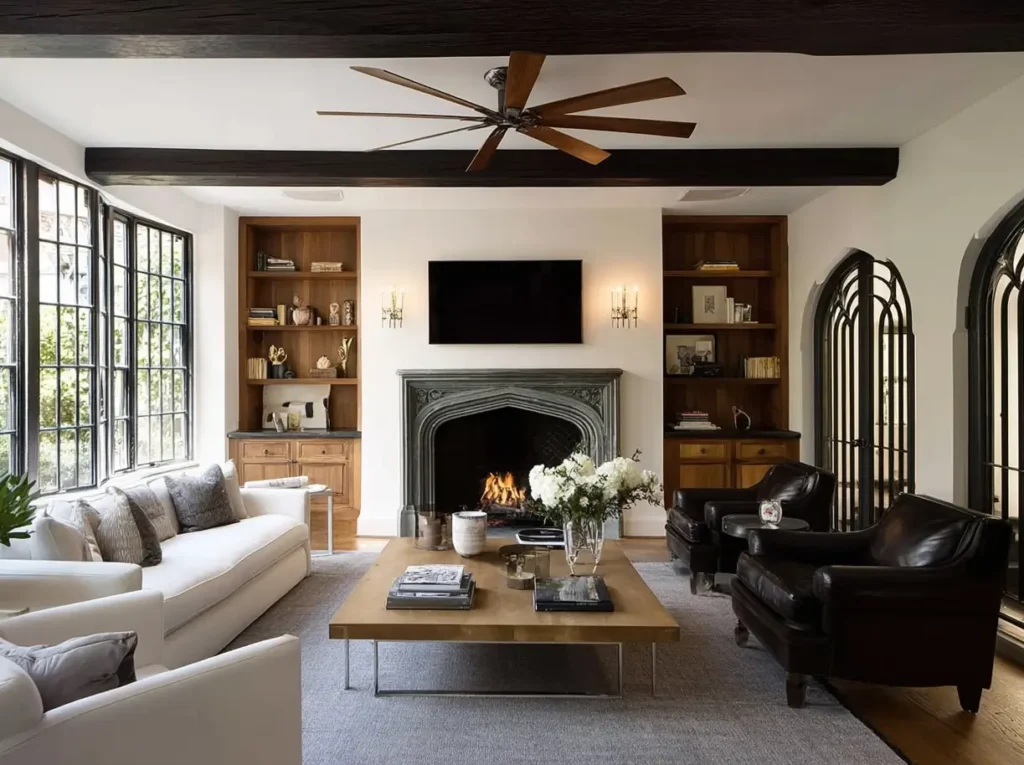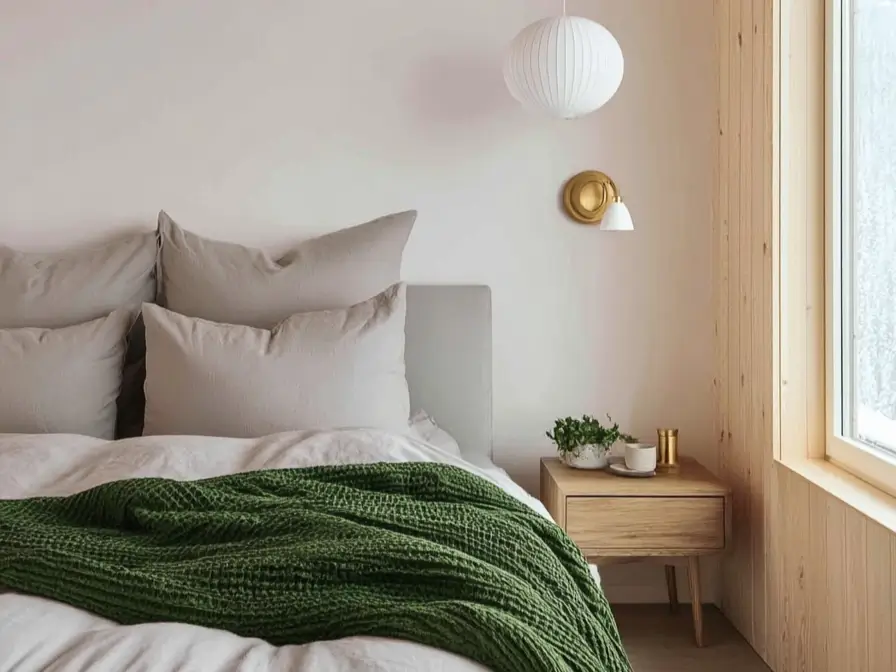Enduring appeal defines contemporary Scandinavian design, a style celebrated for its functional simplicity and serene, light-filled spaces. It’s a design philosophy rooted in hygge—that feeling of cozy contentment—balancing minimalist forms with an inherent warmth that makes a house feel like a home.
Achieving this coveted balance goes beyond just white walls and simple furniture. The true essence lies in the masterful interplay of texture, organic materials, and curated objects. These modern Scandinavian interior design ideas serve as a guide to evolving the look from stark minimalism to a sophisticated, layered interior.
This guide provides the insights and practical inspiration needed to infuse your space with this distinct Nordic design calm. We’ve organized these concepts into the style’s core pillars, from its foundational elements to its finishing touches, to help you create a Scandinavian inspired home design that feels both timeless and completely current.
Key Takeaways
- Core Principles: The style is built on a foundation of maximizing natural light, unifying spaces with natural woods (especially light oak and ash), and layering soft, cozy textures.
- Evolved Palette: While neutrals remain key, the contemporary look warmly embraces an evolved palette of serene blues, earthy terracottas, and rich, muted greens.
- Architectural Details: Wood-slat paneling, stone accents, and a sophisticated mix of materials (like marble and walnut) are defining features.
- Smart Storage: Function is paramount, with an emphasis on seamless, built-in, and modular storage solutions that are both practical and beautiful.
- Curated Comfort: Hygge is achieved through soft, sculptural furniture, iconic lighting, and the personal, sophisticated touch of curated art.
The Core Principles: Light, Wood, and Texture
Every great design starts with its core principles. For contemporary Scandinavian design, this means a mastery of light, an embrace of natural wood, and a deep understanding of textural layers.
1. Unify With Wood

Natural light wood is a cornerstone of this style, used here to create seamless flow from floor to cabinetry. This material choice unifies the open-plan kitchen and dining area, establishing a warm, cohesive look that is quintessentially contemporary Scandinavian design.
2. Maximize Natural Light
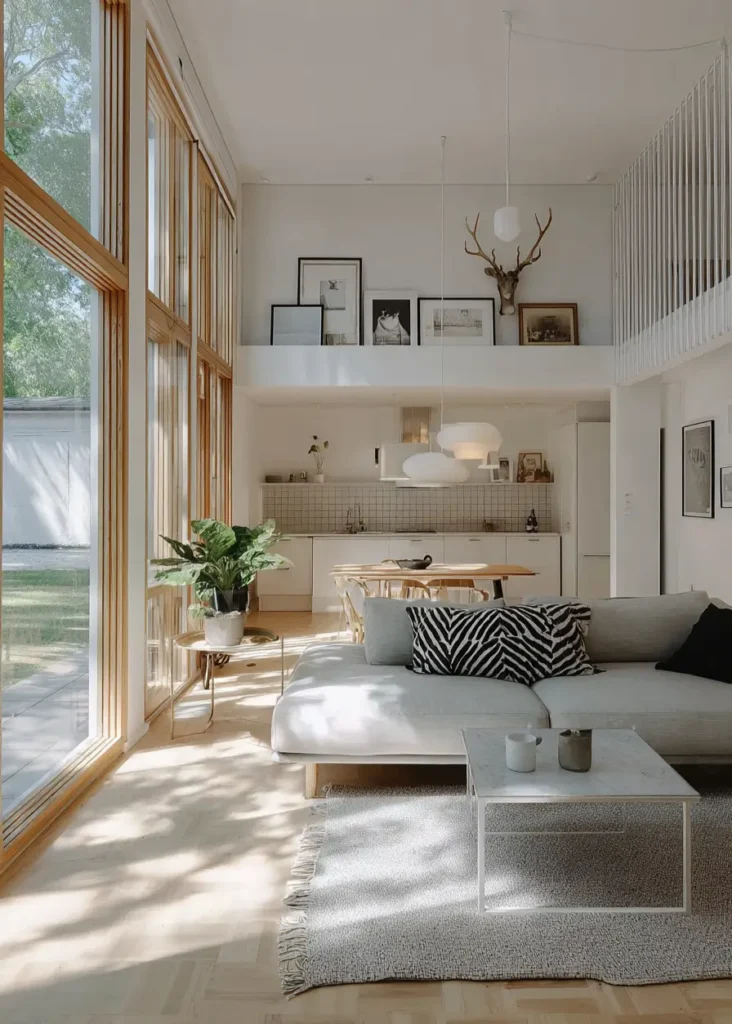
Floor-to-ceiling windows are a hallmark, designed to capture every moment of daylight. This verticality not only brightens the entire home but also enhances the feeling of spaciousness, blurring the line between indoors and the surrounding nature.
3. Layer Soft Textures
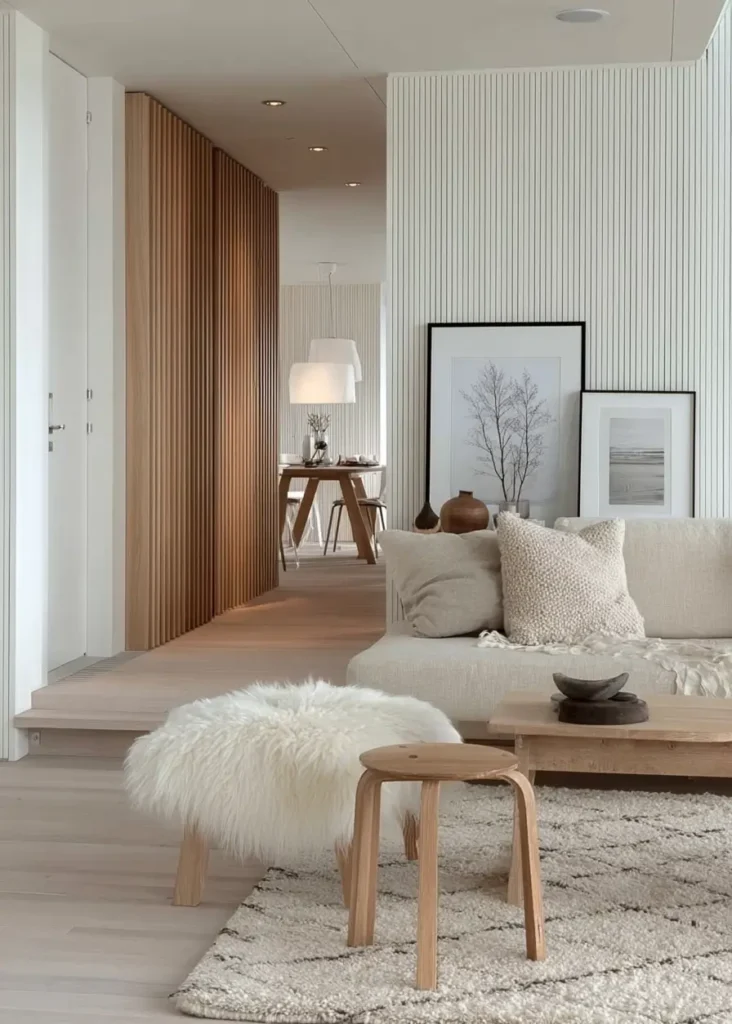
Warmth is introduced through a rich variety of textures. Sheepskin throws, wool rugs, and knit cushions are layered generously to soften the clean lines of the architecture and furniture, adding tactile depth and a sense of coziness.
4. Envelop With Wood

Wood paneling extends across the ceiling and frames the large windows, creating an enveloping, cabin-like warmth reminiscent of modern A-frame home designs. This technique, paired with a neutral palette and simple forms, crafts a serene and cohesive space that feels deeply connected to the outdoor view.
5. Frame The Outdoors
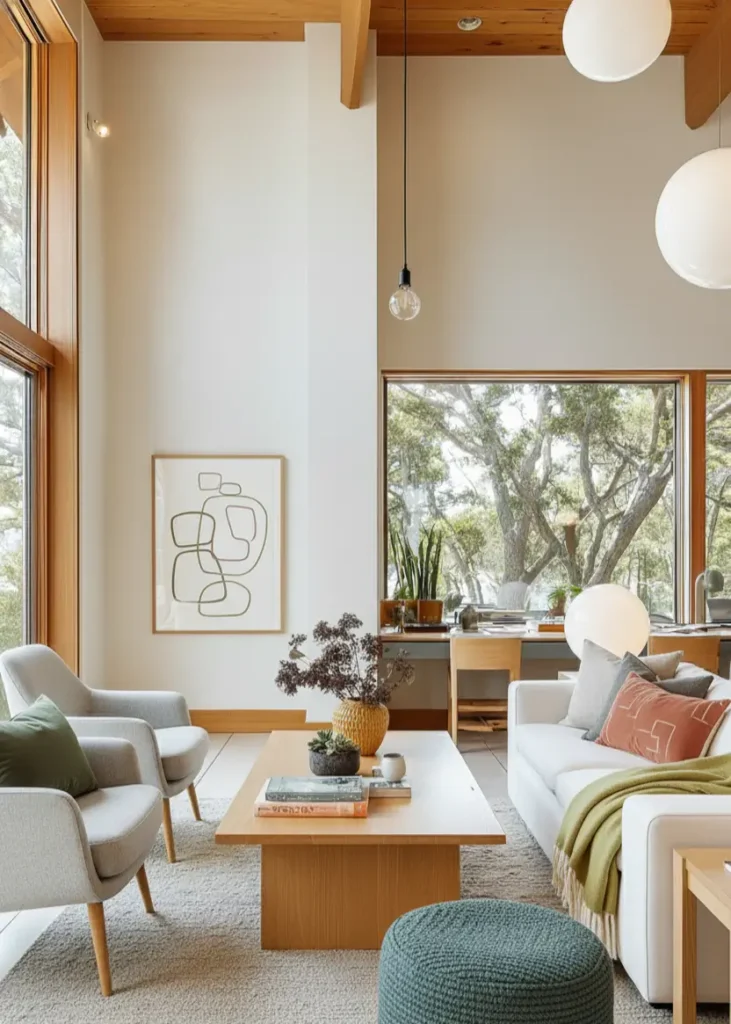
Soaring ceilings and large-scale windows create an airy, open feel. This design move, central to Scandinavian inspired home design, maximizes light and frames the outdoor view, making nature a key part of the interior.
Embracing an Evolved Color Palette
While the style is rooted in light, neutral tones, the contemporary look embraces a more sophisticated and varied palette. Muted, earthy, and sometimes bold colors add personality and depth.
6. Introduce Bold, Playful Color
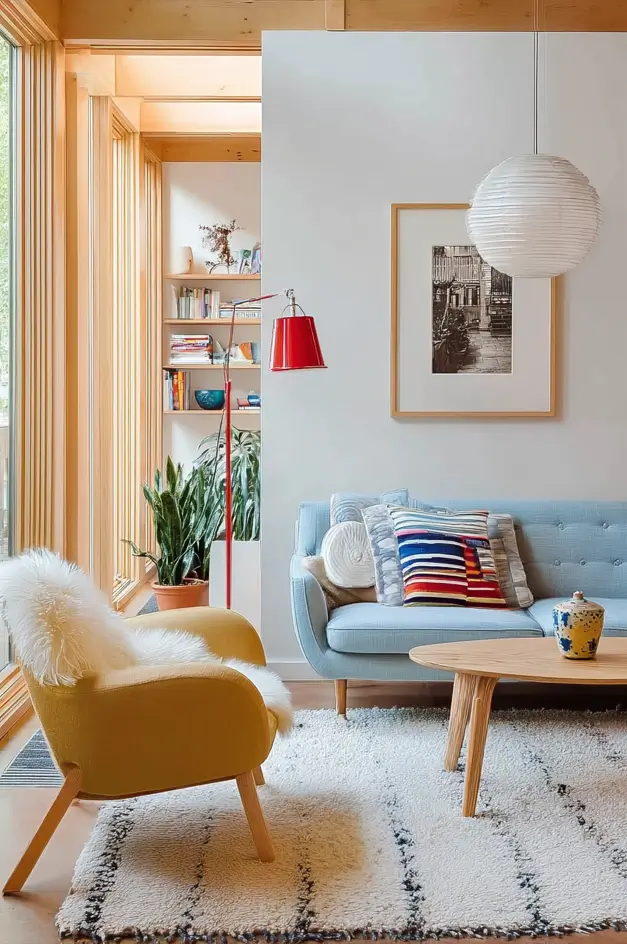
Neutrals provide the base, but contemporary Scandinavian design welcomes saturated color. Here, a bright red lamp and colorful furniture add a playful, personal touch to the serene space without overwhelming the room’s light and airy feel.
7. Ground With Earthy Tones
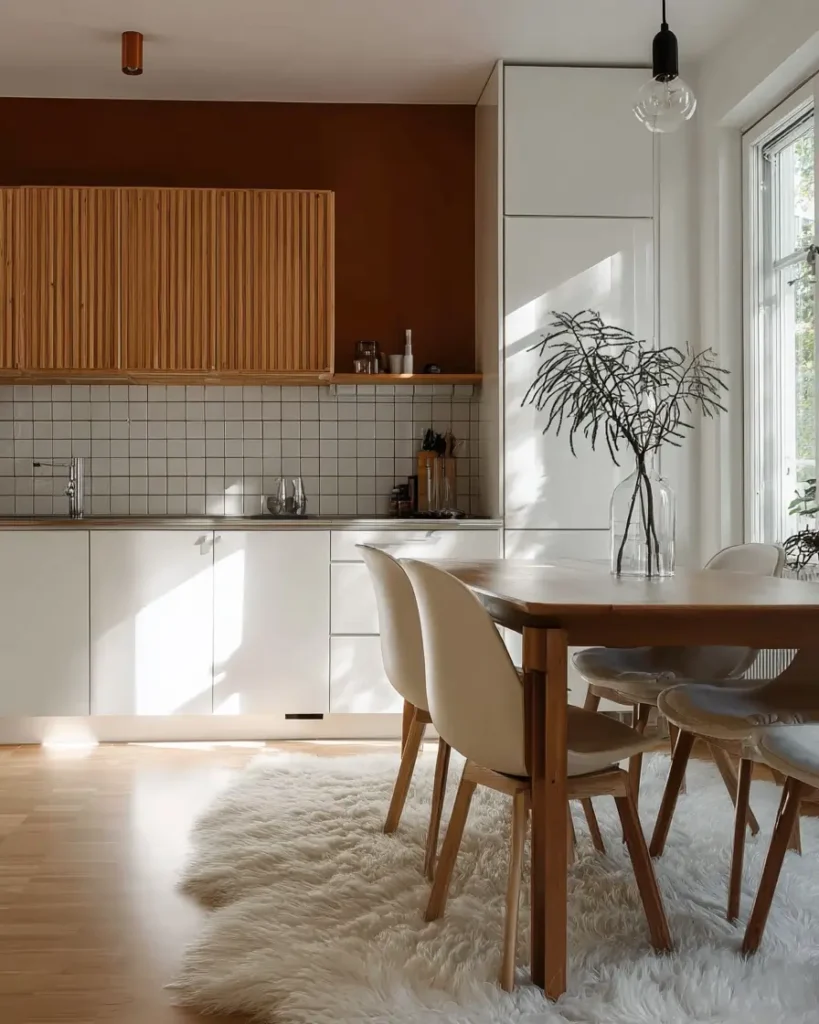
Deep, earthy tones, like this rich terracotta, add sophisticated warmth to a classic white kitchen. Paired with wood-slat cabinets, the color creates a bold, contemporary focal point while maintaining the room’s connection to natural materials.
8. Evoke Calm with Serene Blue
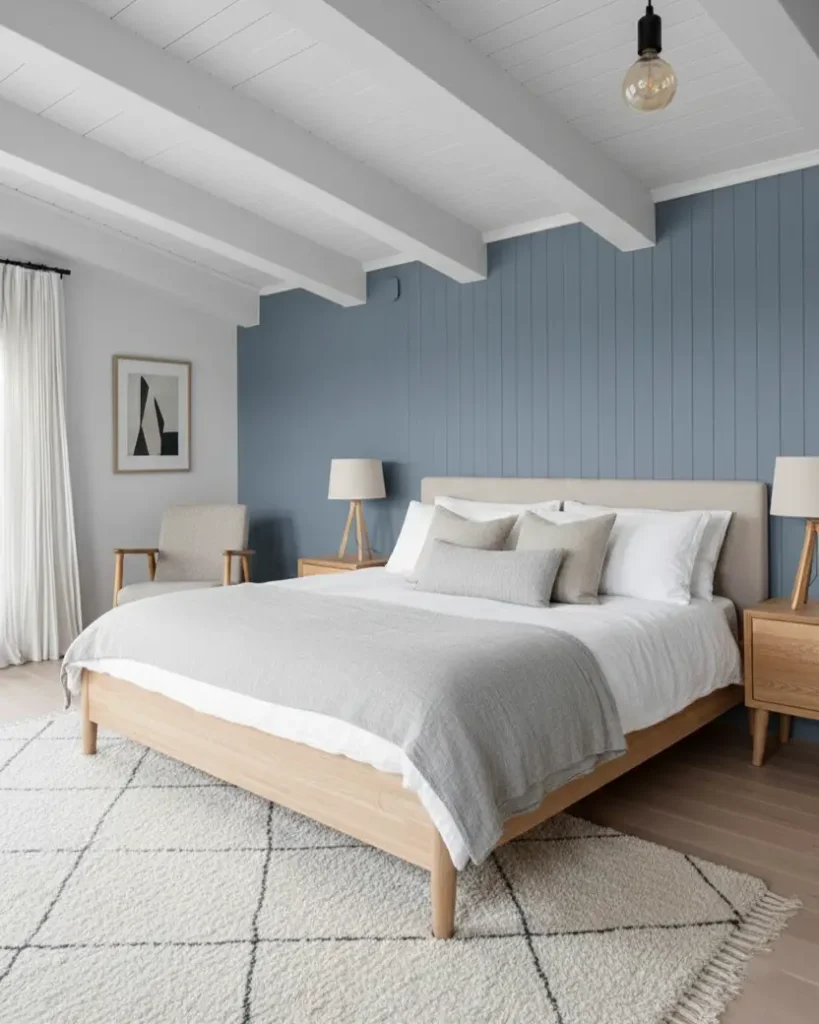
Muted, dusty blue on a feature wall adds a tranquil layer of color. This hue complements the light wood furniture and white-beamed ceiling, enhancing the room’s airy, restful quality without overpowering the space.
9. Commit to Saturated Color

Deep, saturated terracotta unifies the wall and the glossy, three-dimensional backsplash tiles. This bold color-blocking creates a warm, enveloping feel, balanced by simple cream cabinets and the soft, diffused light from an iconic paper lantern.
10. Make a Statement with Graphic Tile
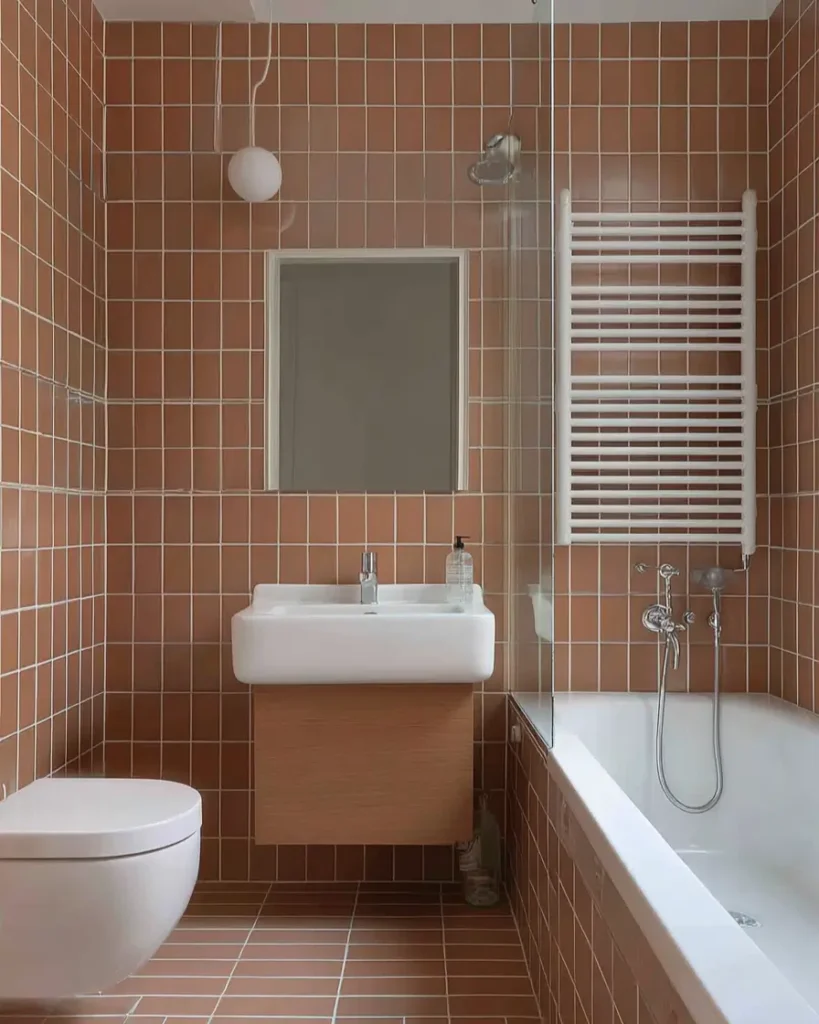
Uniform grid tiling in a warm terracotta hue creates a bold, graphic statement. This retro-modern approach, paired with clean white fixtures and a simple wood vanity, injects personality while honoring the functional, clean-lined roots of Scandinavian inspired home design.
Defining the Look: Architectural & Material Details
This style shines in its details. Wood slats, stone accents, and clever combinations of materials (even the raw textures found in modern concrete house designs) create a space that feels custom, considered, and deeply sophisticated.
11. Add Architectural Interest
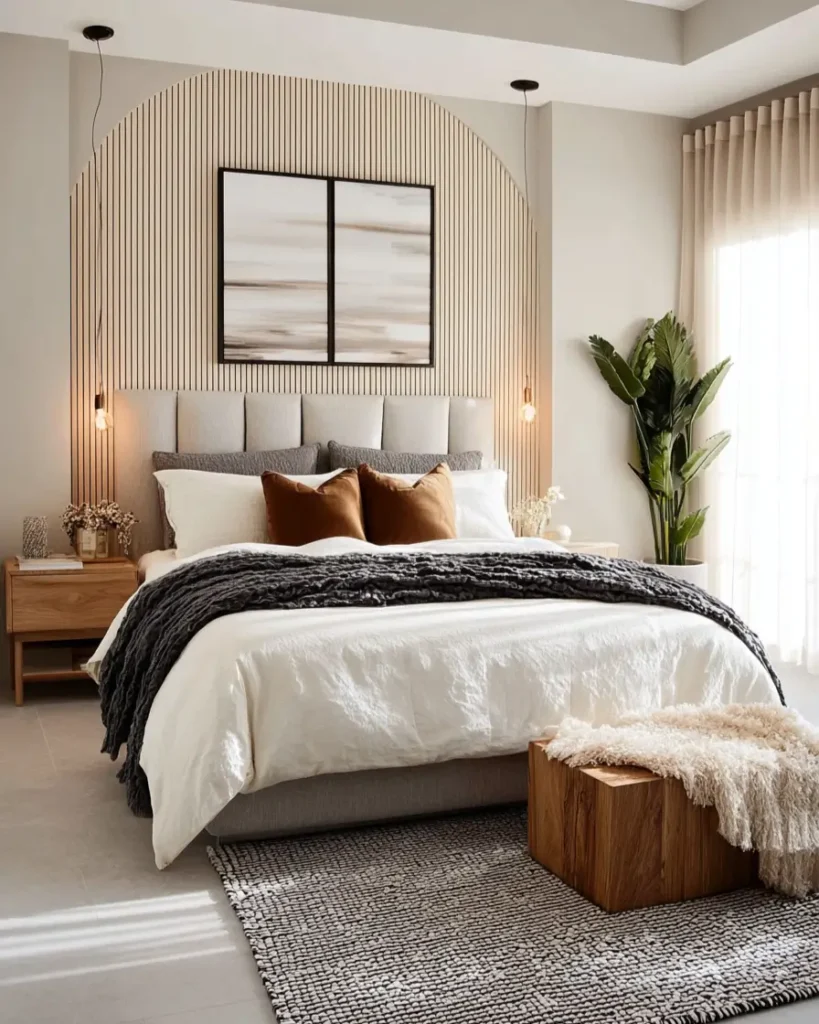
Wood slat paneling creates a sophisticated focal point, adding architectural interest without overwhelming the room’s serene feel. This arched headboard is a prime example of Scandinavian inspired home design, blending clean lines with an organic, inviting shape.
12. Refine With Marble

Clean lines define this kitchen, where handleless white cabinets meet a refined marble backsplash. The wood accent and herringbone floor add organic warmth, balancing the sleek, modern elements. This mix of materials is key to the contemporary look.
13. Embrace Mid-Tone Woods
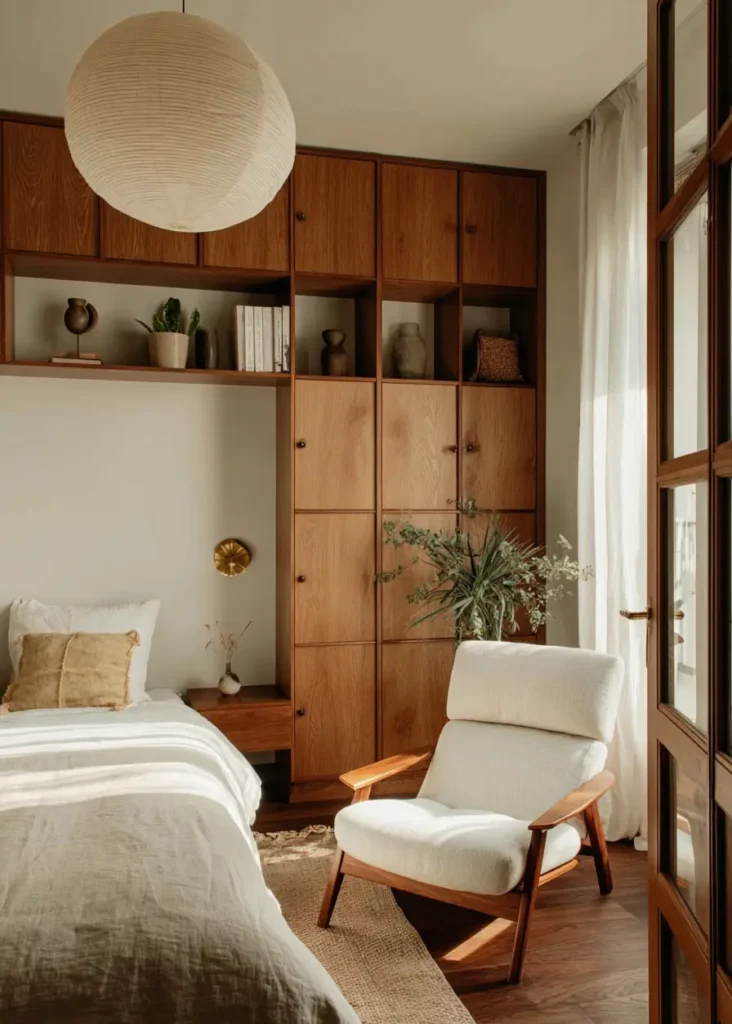
While pale woods dominate, warmer mid-tones add depth and a nod to mid-century roots. This custom built-in provides seamless, functional storage that also serves as a rich, architectural feature, grounding the light-filled bedroom.
14. Balance Wood with Polished Stone
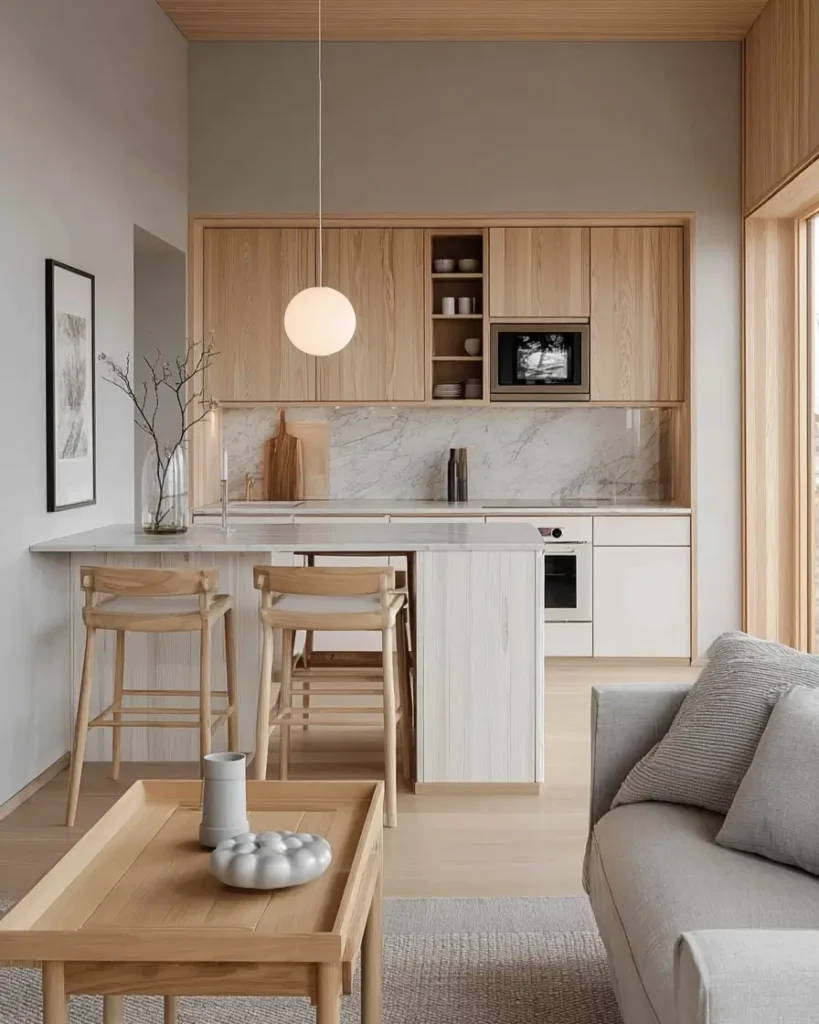
A refined mix of materials defines this space. Light wood cabinetry and ceiling panels provide organic warmth, while a marble backsplash and waterfall island add a touch of polished sophistication. This balance is central to the contemporary look.
15. Create Rhythm with Vertical Lines
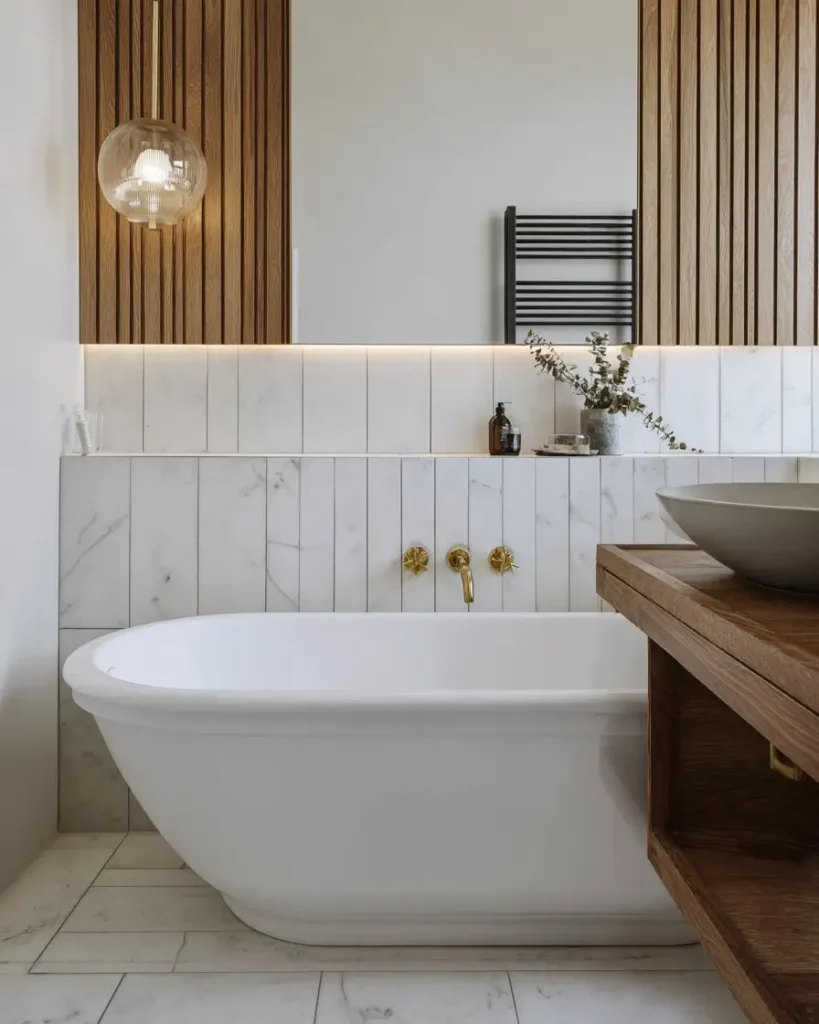
Vertical lines dominate this design, from the rich wood paneling to the veined marble tiles. This textural repetition creates a sophisticated, spa-like atmosphere, while brass fixtures and a glass pendant add a layer of modern warmth.
16. Add Contrast with Rich Walnut
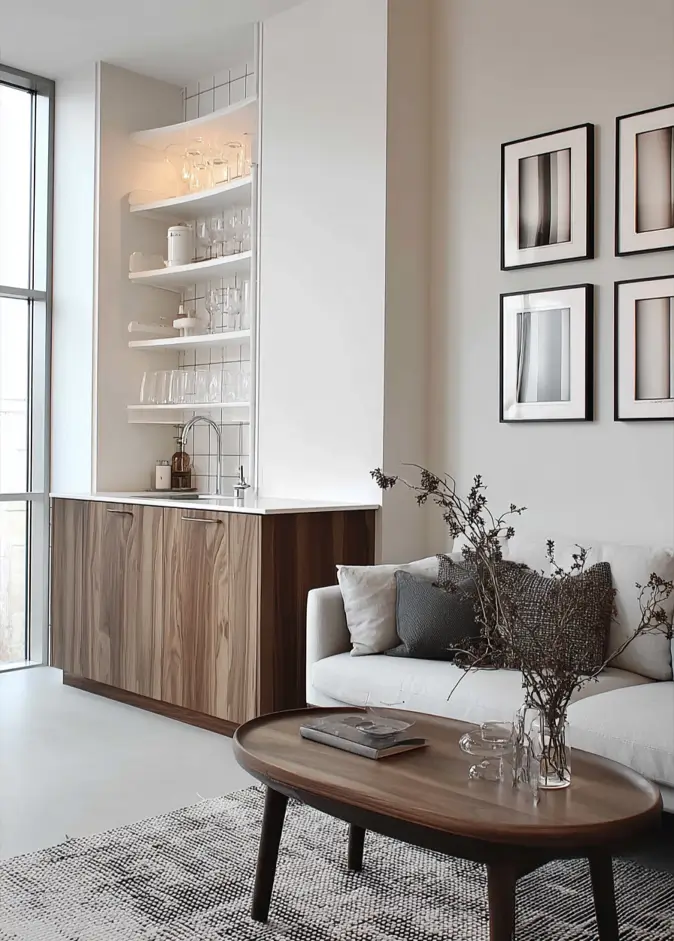
Richer, grained woods like walnut introduce sophisticated contrast to the typical light palette. Paired with white surfaces and open shelving, this built-in bar becomes a warm yet modern feature, showcasing the style’s versatile range.
17. Design a Serene Slat Headboard
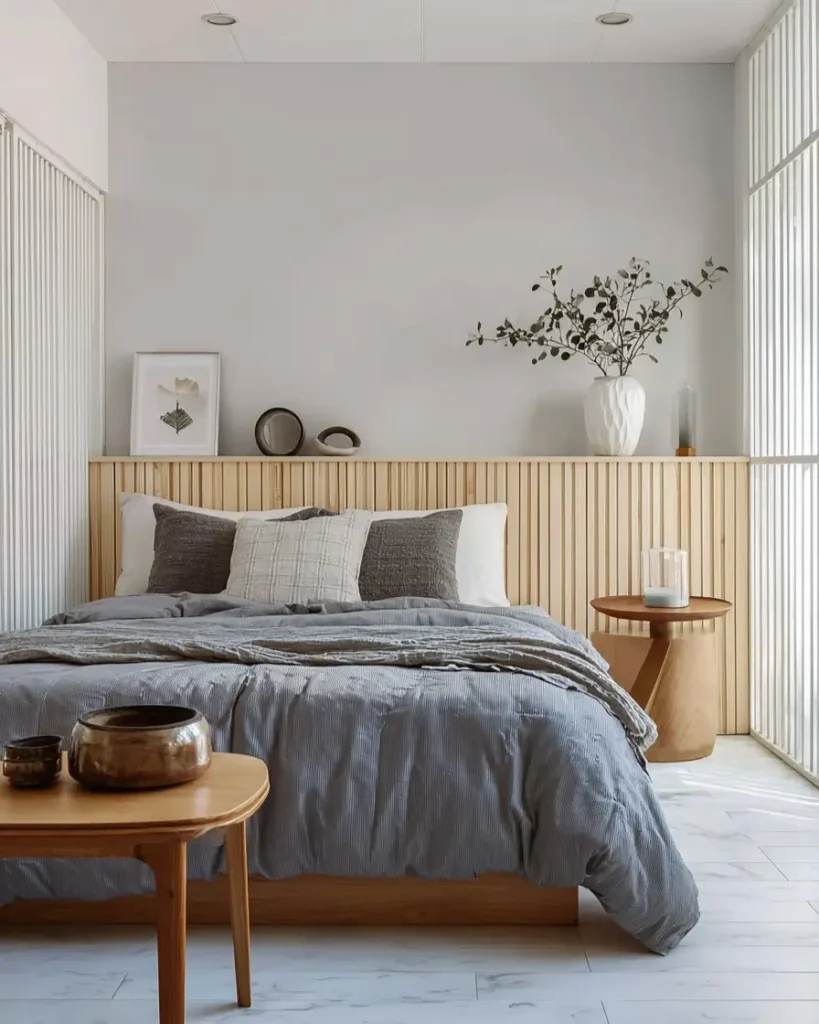
Natural wood slats create a functional half-wall headboard, a perfect DIY approach for small cozy bedroom ideas and adding architectural texture to the calm, grey-toned room. Layered linens in muted blues and greys enhance the restful feel, balancing the clean lines of the furniture and modern, fluted-glass paneling.
18. Integrate the Modern Media Wall
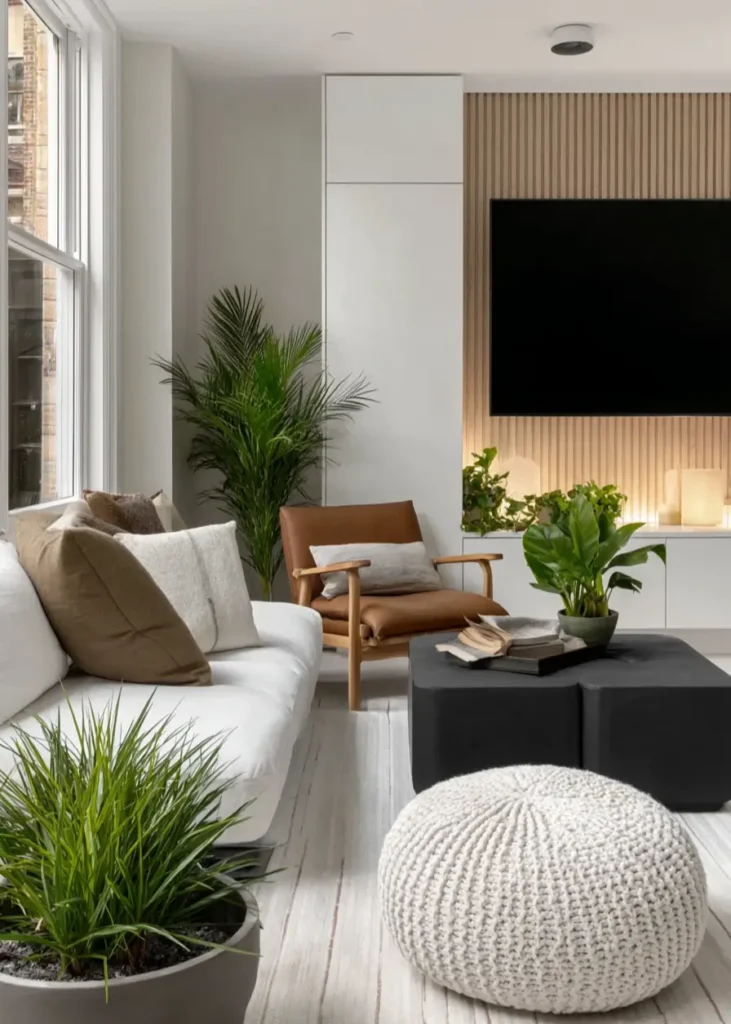
Wood-slat paneling creates a warm, architectural backdrop for the media center. This built-in seamlessly integrates technology with natural texture, while a mix of leather, textiles, and greenery softens the modern lines.
The Functional Heart: Smart Storage & Forms
At its heart, this is a design philosophy of function. Spaces are defined by smart, integrated storage and forms that are both beautiful and practical.
19. Maximize with Smart Built-Ins

Custom built-in storage utilizes every inch of vertical space, a key principle of functional design. Using a warmer, mid-tone wood here adds a sense of depth and a nod to mid-century influences, moving beyond traditional pale woods.
20. Elevate Functional Storage
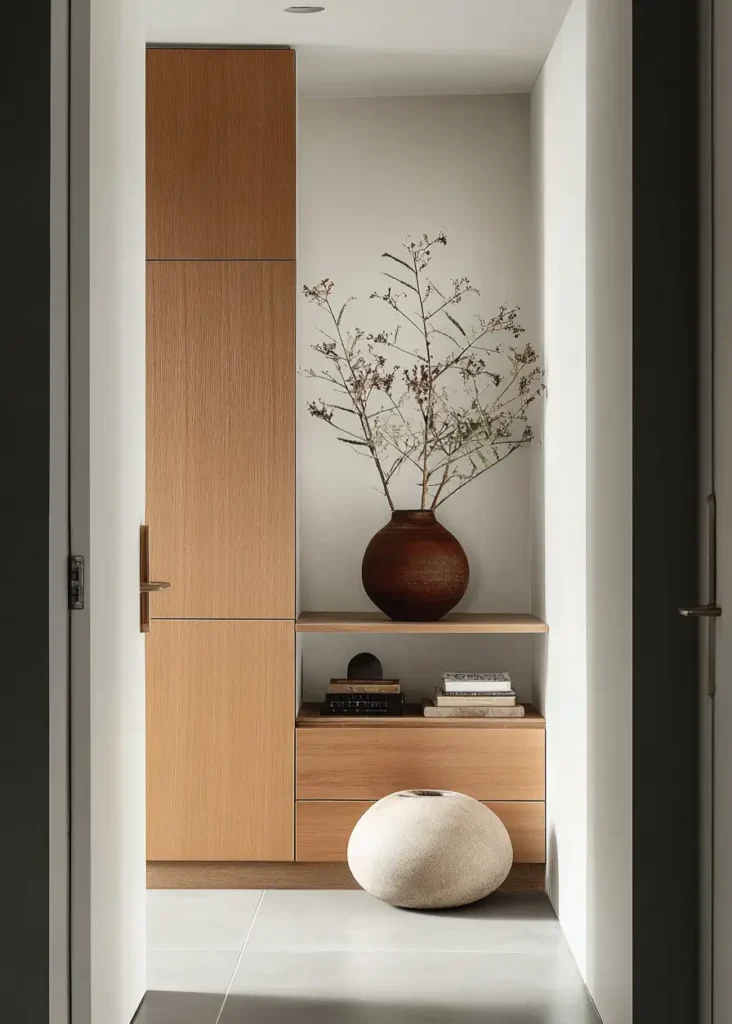
This entryway demonstrates elegance in function. Tall, handleless wood cabinets provide seamless storage, while an open niche creates a purposeful moment to display sculptural ceramics and natural branches, blending utility with curated beauty.
21. Soften Lines with Curved Cabinetry

Fluted, curved cabinetry softens the kitchen’s lines, creating a high-end, bespoke feel. This detail, combined with an open wood niche, breaks up the white expanse and adds a layer of architectural interest that elevates the entire space.
22. Define Zones with Sculptural Forms

Curved wood cladding on the island creates a soft, sculptural anchor in this open-plan room. It beautifully separates the kitchen from the living space, while a unique tile inlay defines the floor, blending function with bespoke detail.
23. Blend Old With New

Classic architectural details, like ornate ceiling molding, are celebrated alongside modern additions. A wood-slatted mezzanine and sleek kitchen cabinetry create a striking, functional contrast, bridging the gap between traditional charm and contemporary Scandinavian design.
24. Integrate Seating and Storage
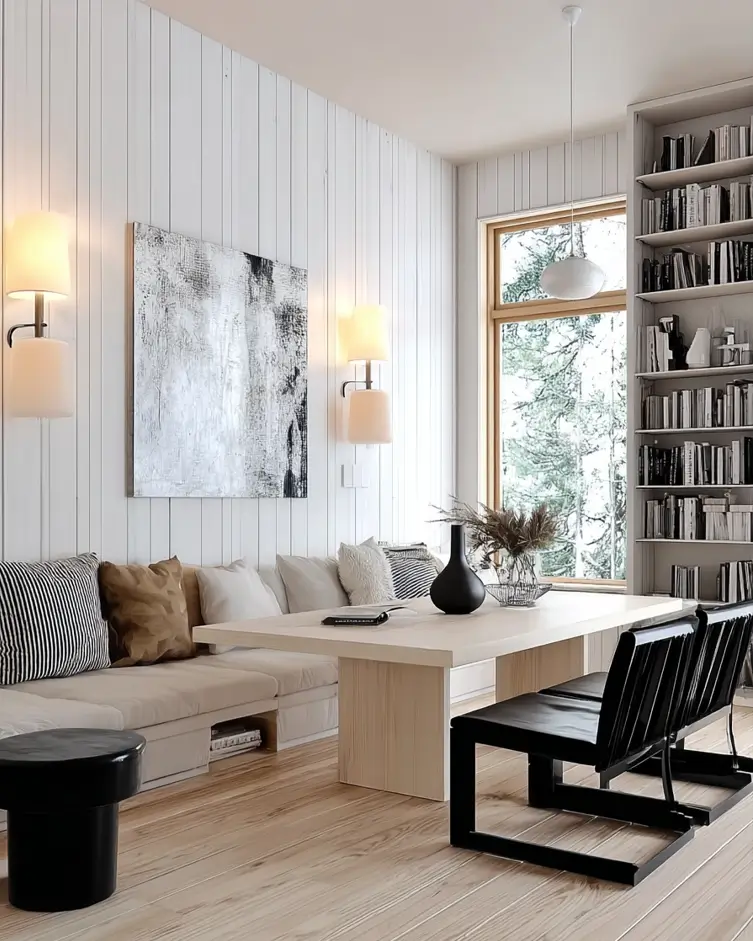
Built-in solutions are a hallmark of this functional style. This dining nook uses wall-to-wall shelving and a cushioned bench, seamlessly integrating seating and storage. Vertical wall paneling adds texture, while black chairs provide a sharp, modern contrast.
25. Classic Modular Storage
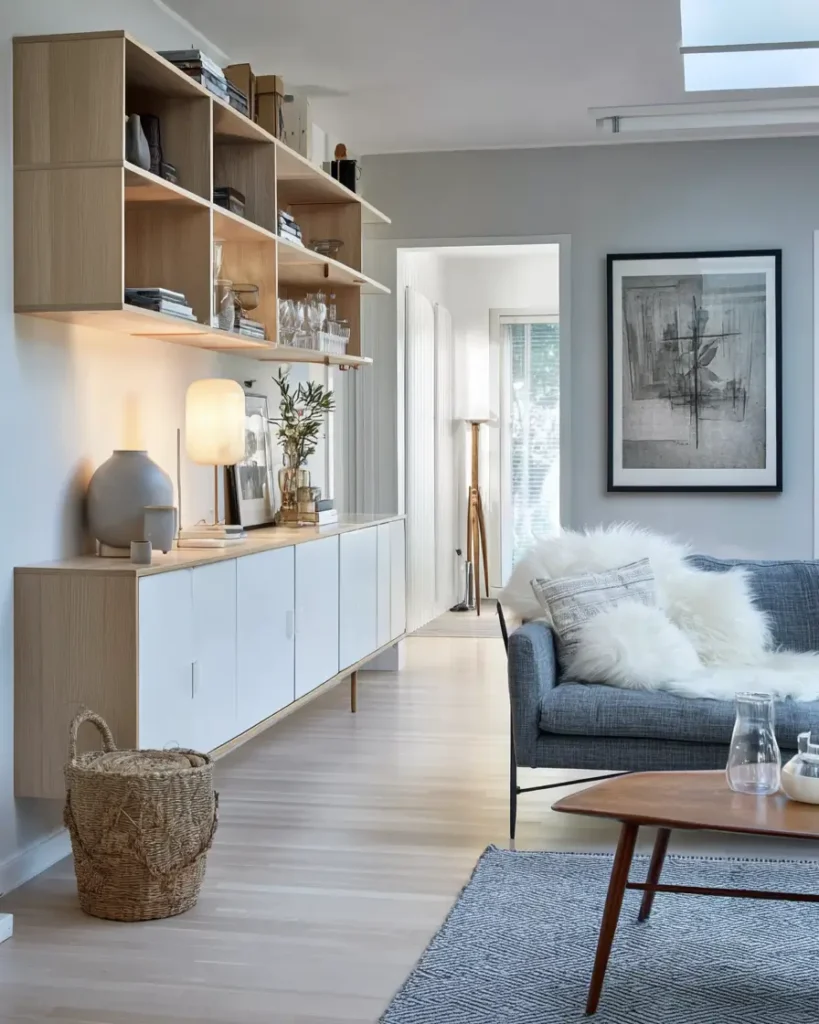
Wall-mounted, modular storage combines open and closed cabinets for a look that is both functional and airy. This classic system, mixing light wood and white, keeps the space feeling open while providing ample room for both display and organization.
26. Blend Function And Color

Space-saving overhead cabinets are a hallmark of functional design, maximizing vertical room. A serene blue accent wall provides a soft, contemporary backdrop, allowing warmer, earthy-toned textiles and natural cane furniture to add a personal, inviting layer.
Creating Hygge: Curated Comfort & Finishes
The final layers are what create hygge. This involves choosing furniture with soft, sculptural forms, layering personal art, and creating cozy, intentional moments for relaxation.
27. Embrace Soft Forms
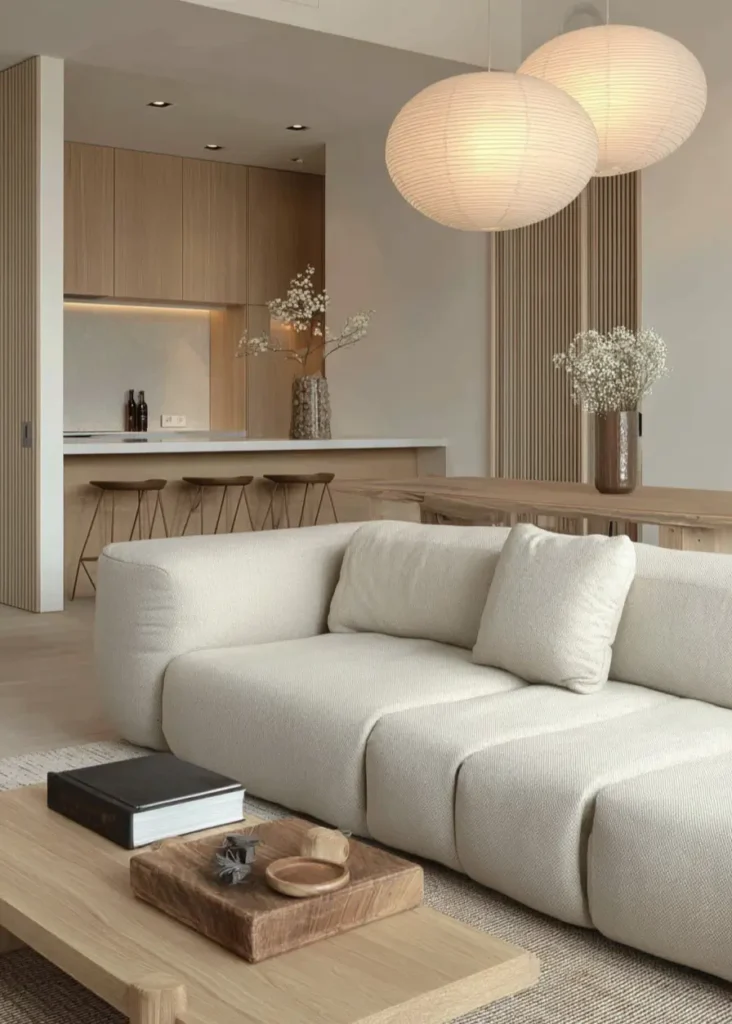
Contemporary Scandinavian design is softening. This space uses a plush, rounded sofa and spherical paper lanterns to create a welcoming, organic feel. These sculptural shapes contrast beautifully with the clean lines of the wood paneling, balancing minimalism with comfort.
28. Sculptural Comfort

Tactile fabrics and sculptural forms turn this armchair into a functional work of art. The chair becomes the clear focal point, inviting relaxation. Paired with simple wood elements and a view of nature, it exemplifies the hygge comfort central to contemporary Scandinavian design.
29. Create Spa Sanctuaries
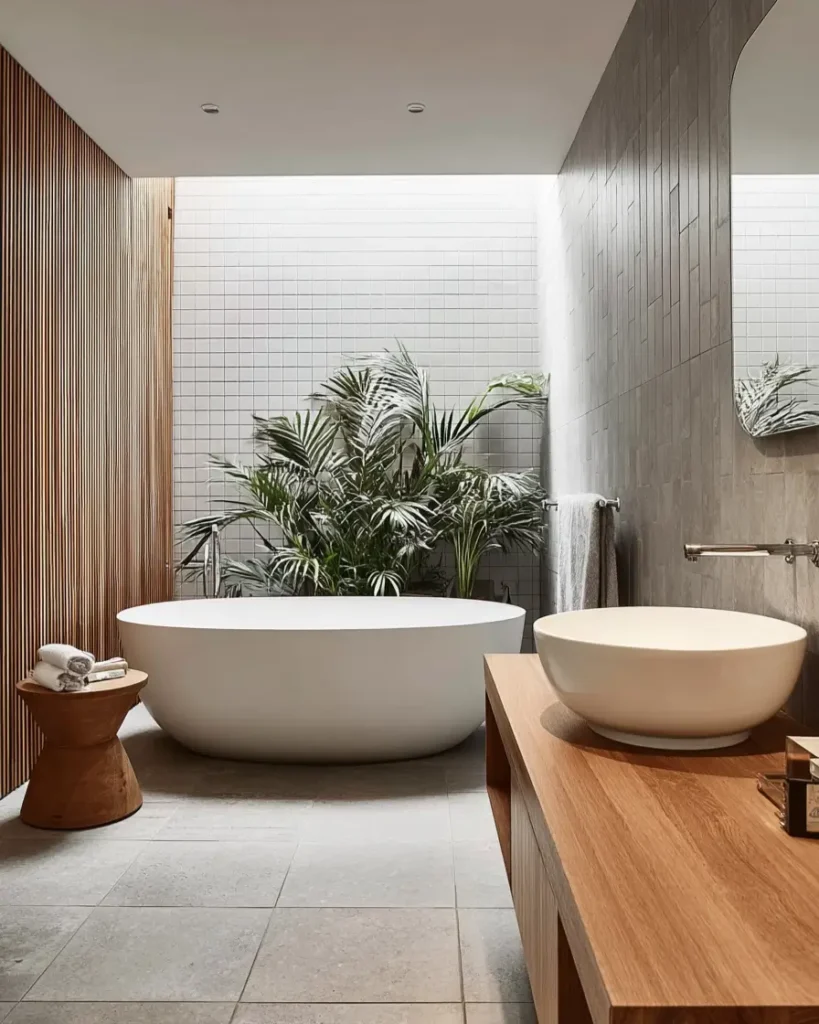
This bathroom translates the style into a spa-like retreat. Wood-slat walls, stone-look tiles, and a skylight create an organic-meets-modern sanctuary. The large plant and freestanding tub complete the feeling of a private, restorative escape.
30. Warm with Natural Rattan
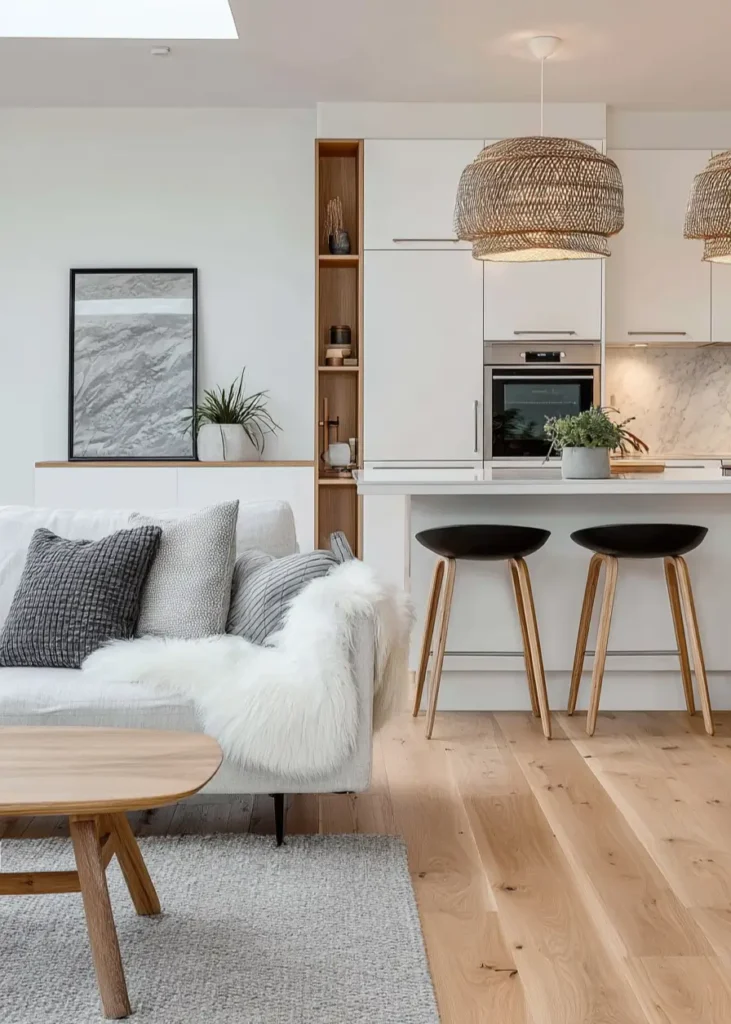
Textural rattan pendants introduce an organic, slightly bohemian warmth to the otherwise sleek kitchen. This layering of natural materials over a clean, modern base is a defining move in contemporary Scandinavian design, adding personality and softness.
31. Layer Tactile Finishes
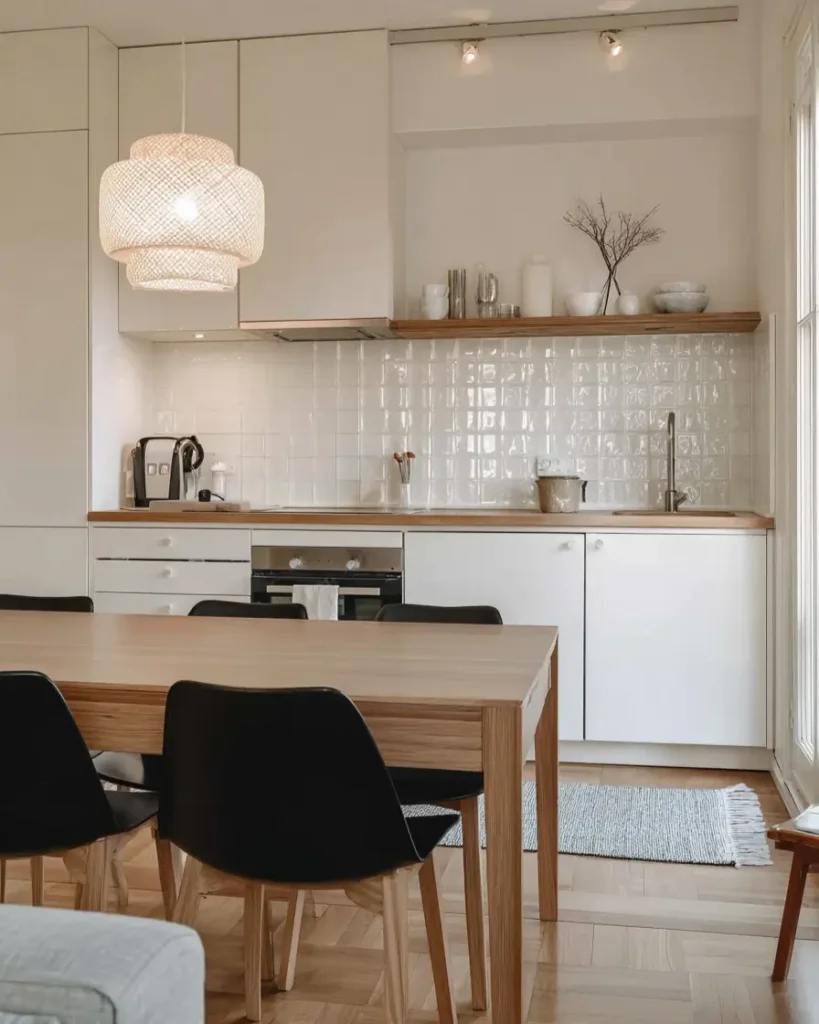
Glossy, imperfect square tiles add a layer of subtle texture to the kitchen backsplash, a clever trick that works well in a modern kitchen design of any size. This tactile finish contrasts with the smooth, flat-front cabinets and is warmed by the wood countertop and parquet floor, creating a balanced, modern look.
32. Mix Art And Texture

Rich bouclé fabric on the sofa introduces immense tactile softness. This cozy texture is balanced by vertical wall paneling and a curated gallery wall, which adds a personal, sophisticated layer. A mustard armchair provides a perfect, muted touch of accent color.
33. Anchor with an Iconic Dining Set
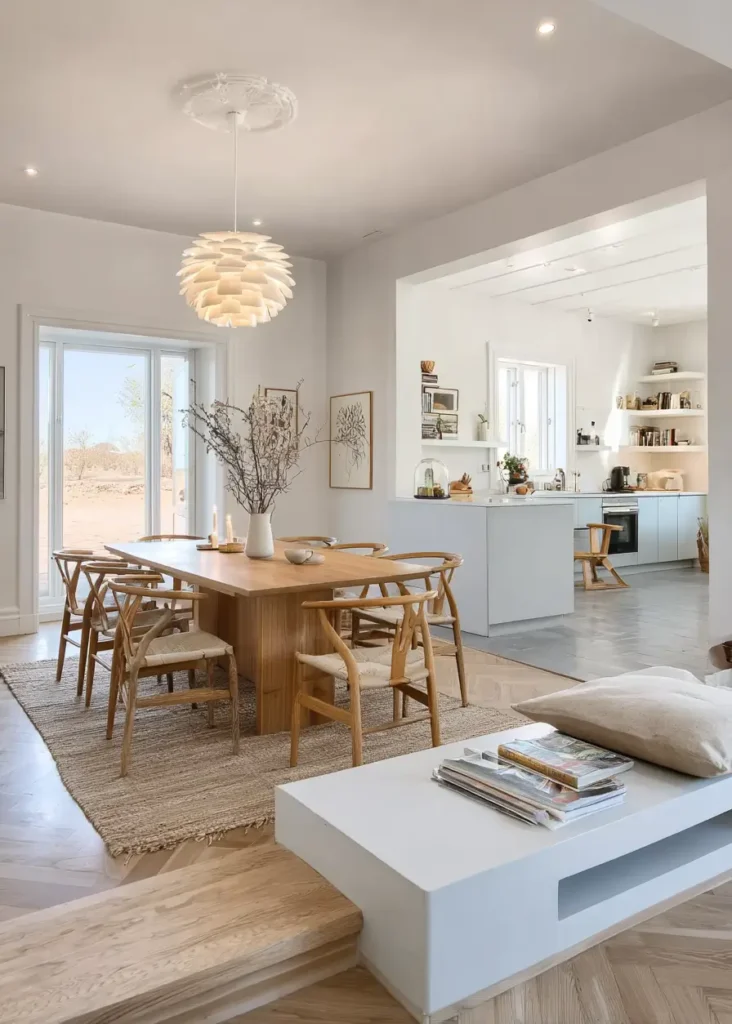
Classic seating, especially a solid wood condo dining table, and a sculptural pendant define the dining space. Set on a herringbone wood floor, this area acts as the warm, central hub connecting the living and kitchen zones in a bright, open-plan layout.
34. Curate Reading Nooks
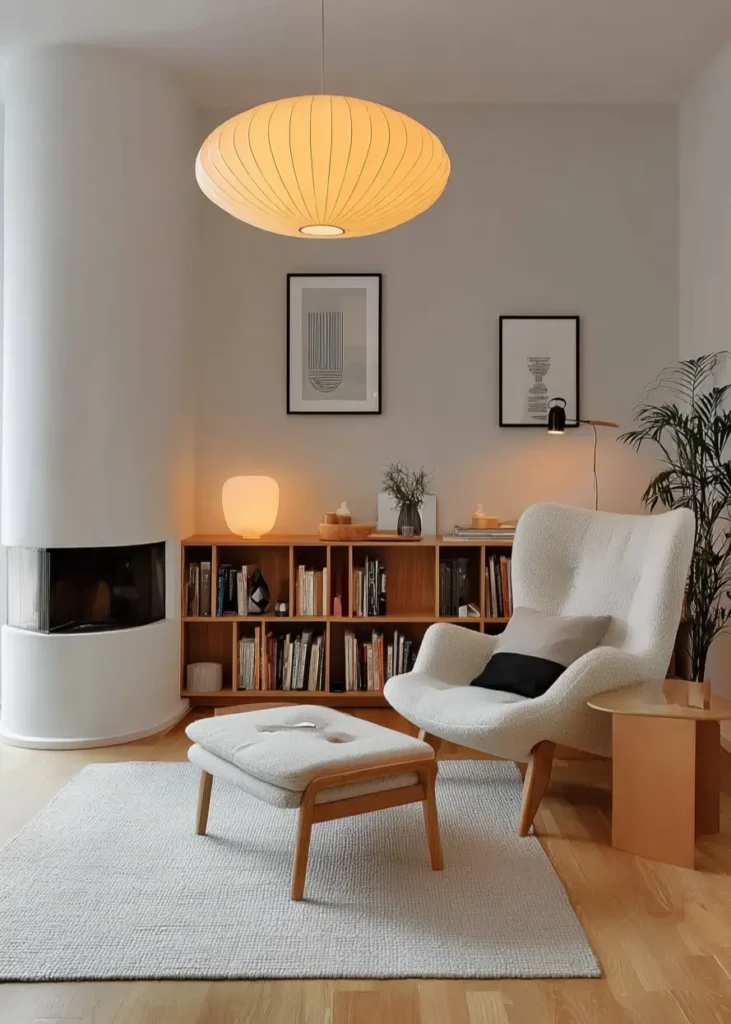
Dedicated corners for reading epitomize the hygge ideal. This space combines a modern fireplace, a plush bouclé chair, and functional low shelving, all under the soft glow of a sculptural pendant. It’s a perfect, quiet retreat.
35. Build a Tactile Foundation
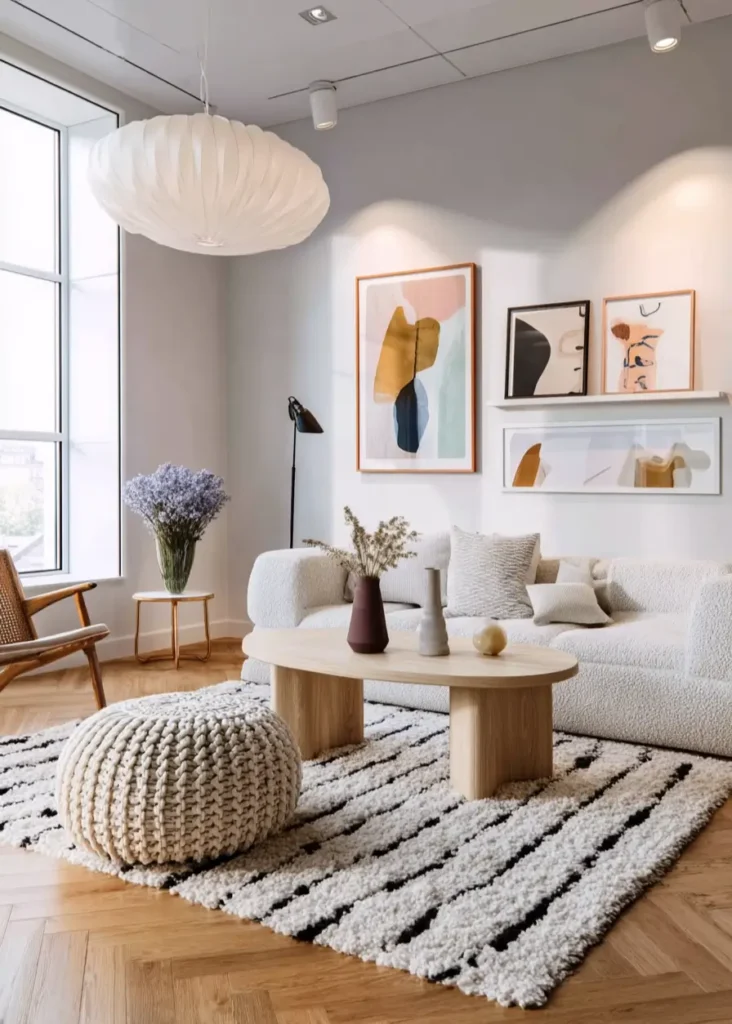
A high-pile Beni Ourain rug and bouclé sofa create a deeply tactile foundation. This cozy base is elevated by a thoughtfully curated gallery ledge and a large, iconic pendant, blending comfort with personal, artistic expression.
36. Personalize With Art

Personal art and bold materials prevent this style from feeling sparse. A dramatic marble-patterned wall and a large portrait add a sophisticated, eclectic layer to the clean lines of the grey sofa and herringbone floor.
37. Curated Vignettes
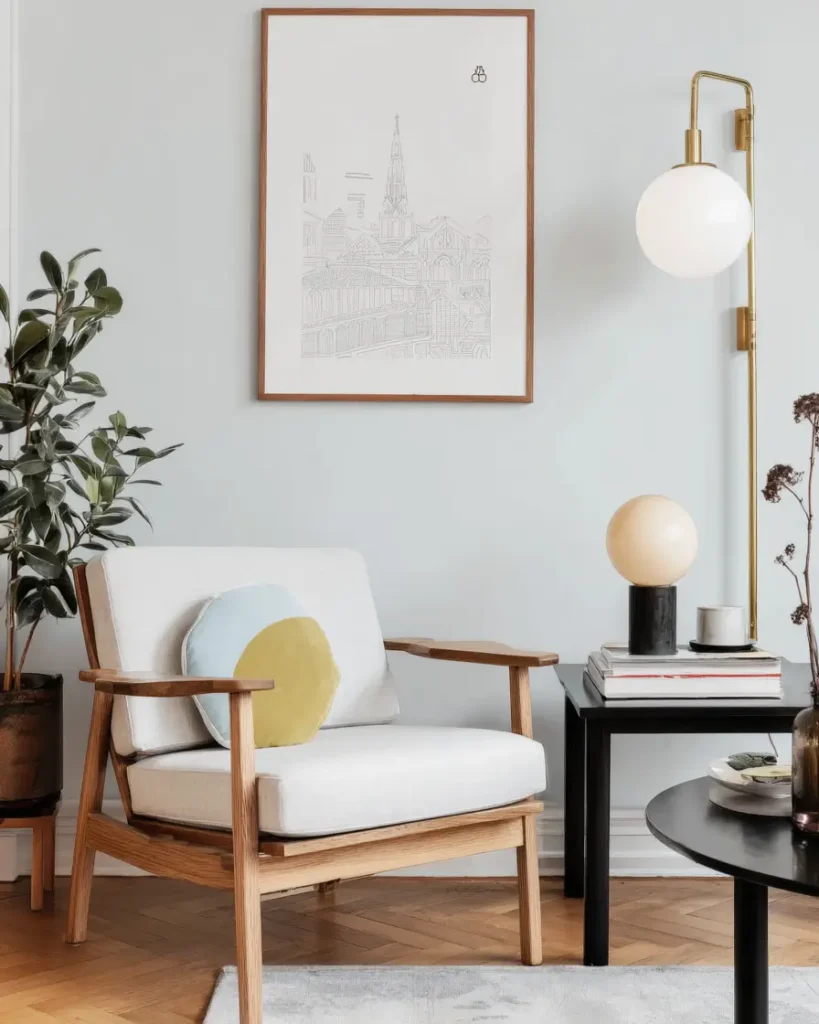
Classic mid-century forms, like this wood-framed armchair, are central to the look. Paired with sculptural lighting and minimalist line art, the corner becomes a sophisticated, curated vignette, showcasing a perfect blend of old and new.
38. Use Iconic Forms

Iconic, sculptural furniture adds personality and a collector’s sensibility. The soft, tufted sofa and colorful, low-slung chairs create an inviting and sophisticated lounge area, proving that comfort and high design can coexist beautifully.
39. Master Soft Minimalism
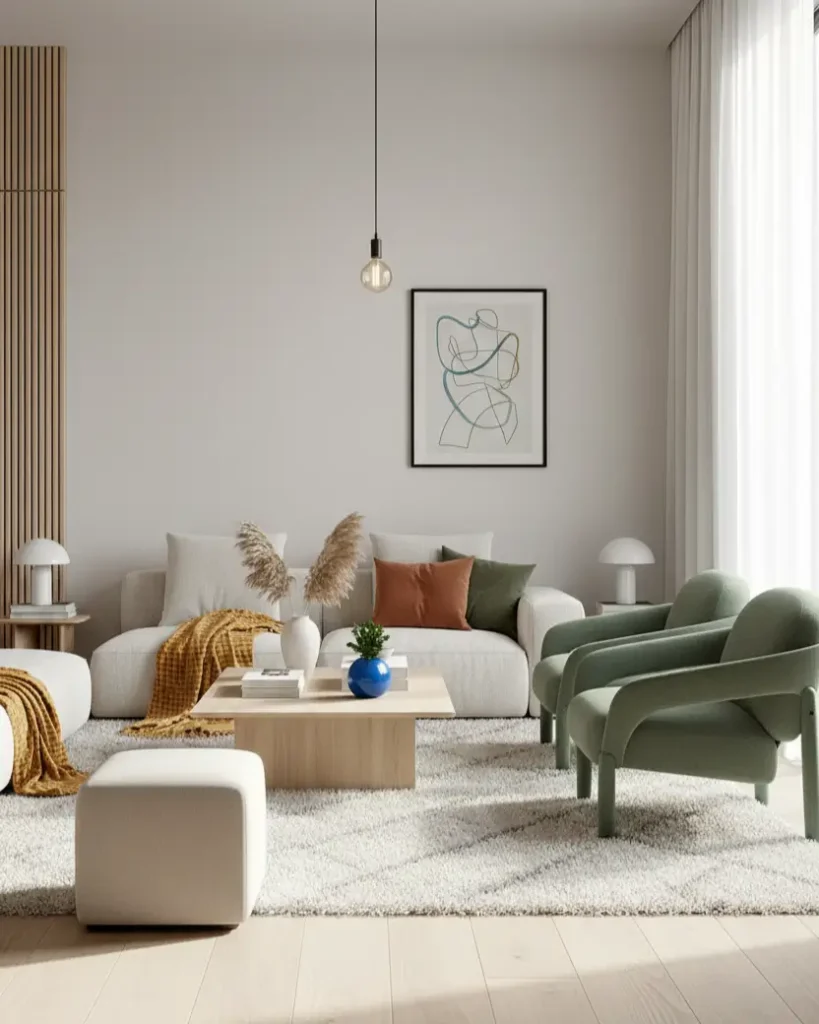
This space embodies a soft, minimal approach. A high-pile rug and muted, earthy textiles provide comfort, while sculptural chairs and modern art add points of interest. The wood-slat detail adds a final layer of architectural texture.
How to Apply This Style: A Practical Guide
You’ve seen the inspiration, now here is how to bring contemporary Scandinavian design into your own home, even if you just have a cozy small apartment.
Where to Start: A Simple 3-Step Plan
It can be overwhelming to know where to begin. Follow this simple plan:
- Declutter and Curate: This style is built on the principle of lagom—not too much, not too little. Before buying anything, edit your space. Remove clutter and keep only the things that are functional or truly meaningful.
- Define Your Base: Start with the foundation. Choose a light, neutral paint color (like a soft white, pale grey, or warm beige) to maximize light. Assess your flooring—light wood floors are ideal, but a large, neutral-toned rug can work wonders.
- Invest in One Key Piece: Don’t try to do everything at once. Focus your budget on one high-impact, quality item that defines the style. This could be a sculptural pendant light for the dining room, a plush bouclé armchair, or a well-crafted oak coffee table.
Key Tips by Room
- The Living Room: Focus on texture. Combine a clean-lined sofa with a high-pile rug, knit throws, and linen cushions. Ensure your storage is sleek (like a floating media console) and add a statement armchair. Many classic Danish modern pieces work perfectly here.
- The Kitchen & Dining: Prioritize light wood and clean lines. This could mean oak-fronted cabinets or a simple, solid wood dining table. Use iconic pendant lighting to anchor the dining area.
- The Bedroom: Create a serene retreat. Use a muted color palette (like the serene blues or soft greys we saw) and layered, natural bedding (linen is perfect). A wood-slat headboard or wall panel can add instant architectural warmth.
What to Look For: 4 Key Furniture Pieces That Define the Style
- Sculptural Lighting: A beautiful pendant light (paper, rattan, or metallic) is non-negotiable. It acts as the “jewelry” of the room.
- A Statement Armchair: Look for a piece that blends comfort with form—think a classic mid-century design or a modern, soft bouclé chair.
- Natural Fiber Rugs: A high-quality rug in wool or jute adds essential warmth, texture, and sound absorption.
- Well-Crafted Wood Furniture: Invest in solid wood (or high-quality veneer) pieces with clean lines, from a coffee table to a dining set.
3 Common Mistakes to Avoid
- Making It Too Sterile: A common mistake is creating a space that is all white and empty. This isn’t minimalism; it’s a hospital. Remember hygge—it must be cozy! Add plants, art, books, and rich textiles.
- Forgetting Function: Don’t let your space become a showroom. Every item should have a purpose. This style is beautiful because it is functional. Ensure you have smart, ample storage to keep clutter hidden.
- Choosing “Fast Furniture” Knockoffs: The style is built on a philosophy of quality and craft. Cheap, flat-pack imitations often miss the mark on material quality and proportion, and they won’t last. It’s better to save for one quality piece or shop for vintage.
Our Final Take
Ultimately, contemporary Scandinavian design is a celebration of thoughtful, functional, and personal spaces. It’s not about rigid minimalism but about the art of curating a serene environment—the core of the modern Scandinavian interior design idea—that balances clean lines with organic warmth, allowing you to live beautifully and comfortably every day.
Your Questions, Answered
What is the difference between Scandinavian and contemporary Scandinavian design?
Think of it as an evolution. Classic Scandinavian is simpler, while contemporary Scandinavian design is more layered, introducing richer textures (like bouclé), softer forms, and a wider color palette that includes stone, richer woods, and earthy tones.
What are the key elements of contemporary Scandinavian design?
The style is defined by five key elements: 1. A light, neutral palette that maximizes natural light. 2. A focus on natural materials, especially light woods. 3. The concept of hygge (coziness). 4. Functional, clean-lined furniture. 5. Layered textiles and sculptural lighting.
How do I make Scandinavian design feel warm and not too minimal?
The secret is layering. To avoid a sterile look, introduce a rich mix of textures like knit wools, sheepskin, and bouclé. Also, incorporate personal art, plants, and varied wood tones—not just white or pale oak.
Is Scandinavian design the same as minimalism?
No, they are different. Minimalism is a “less is more” philosophy that can feel cold. Contemporary Scandinavian design is a “livable minimalism” built on hygge (coziness) and functionalism. It’s designed to feel warm, personal, and inviting.
What is the difference between contemporary Scandinavian and Japandi design?
It’s about palette and mood. Contemporary Scandinavian is brighter and cozier, built on hygge. Japandi, a hybrid style, is more muted and earthier, borrowing heavily from Japanese home interior design. It often uses darker woods (like walnut) and embraces the rustic imperfection of wabi-sabi (as defined by sources like the Tate museum).
What’s the best way to start if I’m on a budget?
The style’s core principles are very budget-friendly. You can achieve an affordable Scandinavian design by starting with decluttering (which is free) and a fresh coat of light, neutral paint. Then, focus on textiles. Be patient and shop for second-hand, well-crafted vintage pieces.

